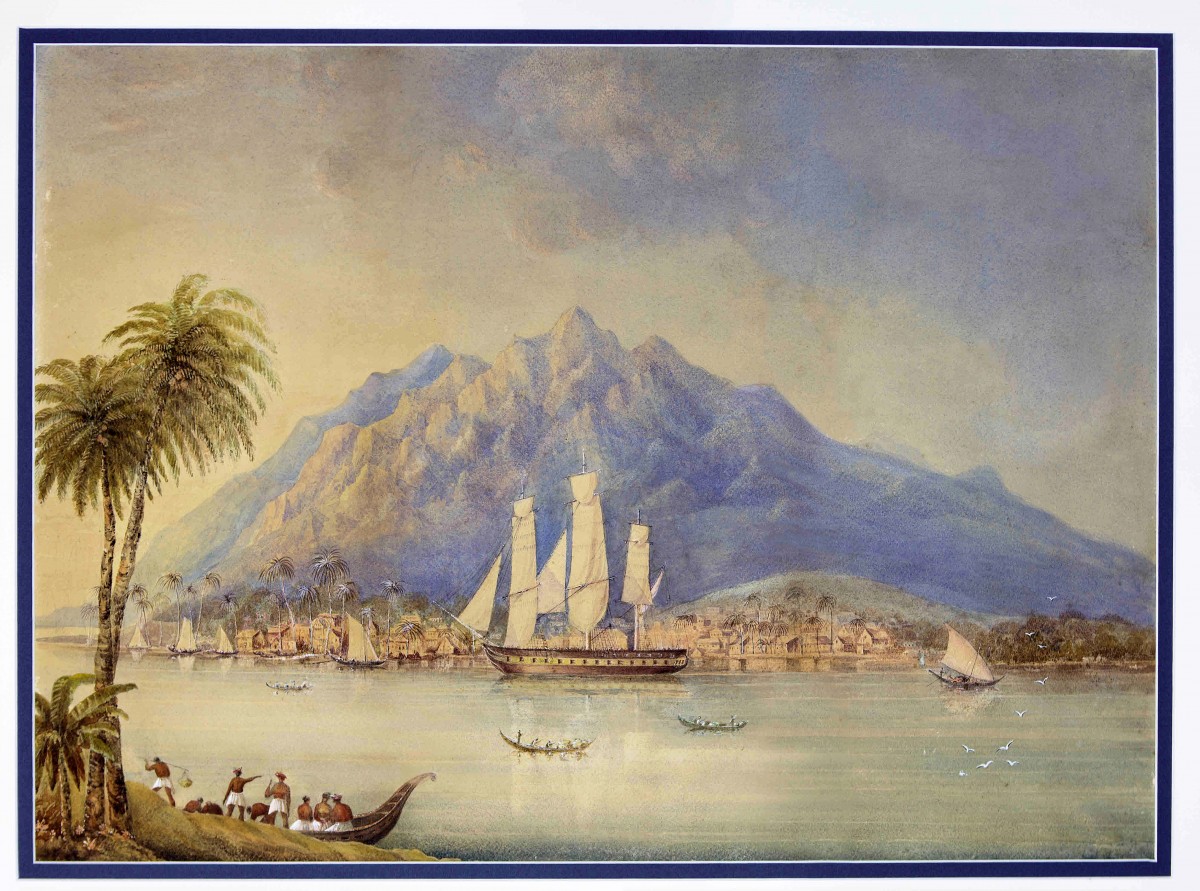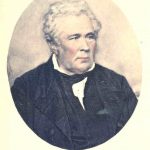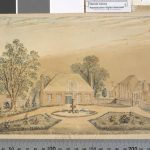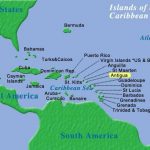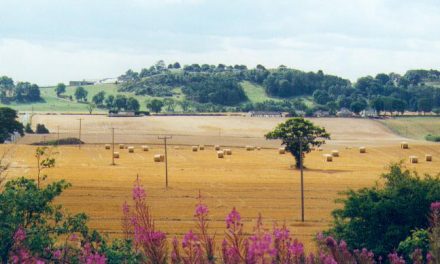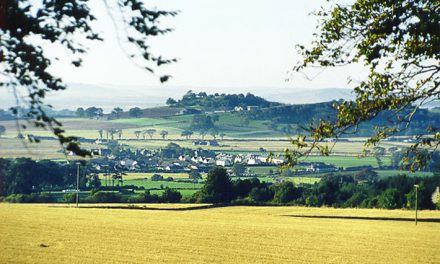After many years of search we believe we may at last have an image of the Skelton barque on which William and Margaret voyaged to Van Diemen’s Land. This photograph was taken recently (2017) from an original painting owned by Mr Ian Brown of Sydney (## see footnote), who has very kindly granted us permission to display it here.
Our thanks for this discovery are due to our research colleagues Mike Wilson and Jenny Brown, Mike for tracking down the existence of the painting and its possible general location, whilst Jenny focused us to a member of the Headlam family who was able to tell us just where it was. Mike has also produced the documents linked here, Items of Interest Related to the Skelton, and here, Comparison – Skelton, Polly Woodside, Lady Nelson, Windeward Bound. In addition: Wikipedia re Skelton.
The ship depicted as the Skelton in the painting is certainly of a three masted barque, and from the gunwale ports count comparison with the Polly Woodside would suggest a tonnage to the order of about 300. Furthermore the Lloyds Register describes Skelton as having a copper sheathed hull: the hull of the painted image from its colour and sheen would leave little doubt of a match on this. The painting has a frame of Tasmanian Musk wood implying the likelihood it was painted and framed in Tasmania sometime prior to the supposed artist G B Fraser arriving in Victoria with it in 1839. Tasmanian Musk wood is very distinctive, rare and expensive.
An image of Captain Dixon, owner and master of the ship on its voyages to Australia in 1820 and 1822 is also shown in the gallery below – click on gallery images to enlarge them.
The Headlam family were fellow travellers on board the Skelton in 1820. It is known that the painting was in the possession of members of the Roadknight family, in particular Alfred Hill Roadknight. Three generations of the Roadknight family were voyagers on board Skelton, Alfred’s father Thomas was one and he was aged 6/7 at the time of the voyage. One can imagine the excitement of a young lad of a 5 month voyage on the high seas- it would feature strongly in his mind all his life.
Members of Brown, Roadknight and Hill families were well known to one another in Hobart and later in the Geelong area, the Roadknight and Brown families being very involved in the Geelong Historical Society, and historical matters generally. Ian’s late father, Dr Philip Brown, acquired the painting at an Estate auction of chattels from the Estate of Alfred’s daughter, Gladys Clare Roadknight after she died in 1971.
Alfred Roadknight’s mother, Caroline Frances Hill was the daughter of one John Sleath Hill, the Hill family having come from London in the early 1830s. This chart depicts the ownership trail which we have been able to trace so far, Skelton Painting Ownership Chart Based on research to Feb 2018 – readers will note the close family connections of all involved.
Identification of the artist of the painting had been somewhat uncertain, and for the present the painting’s subject continues to be so. An alleged ID we are advised by Ian Brown being a handwritten note on the painting’s back saying it is the Skelton, placed there in the past presumably by an earlier member of the Roadknight or possibly Hill families, this note also referring to ‘Captain Hill’s ship’. Just what this means is uncertain : he owns this ship ?, he travelled on this ship at some stage ?, and which Captain Hill ?
There has been a suggestion that Captain Dixon might have displayed some artistic flair – if he did indeed create this image we must assume he was an accomplished artist as well as mariner: he is said also to have produced a painting of his later residence beside the Isis River in Tasmania, west of Campbelltown – a residence he named Skelton Castle – shown below. This painting is held by the Dickson Gallery, Mitchell Library in Sydney, and may be viewed by appointment. It is displayed in our Gallery below courtesy of The Dickson Gallery. To this writer (with no artistic expertise) the image of Skelton has a fairly professional look to it compared to the Skelton Castle image so that if Dixon did paint the latter it would seem to rule him out for the Skelton image. But other evidence also rules Dixon out as artist.
As advised by Ian Brown, and also as stated in his late father’s 1970s notes about the painting, they took the painting out of its frame and discovered on the front lower left hand corner, the previously hidden (by the frame) signature G B Fraser – it seems quite plausible that we must accept this as the artist’s name being precisely where an artist would traditionally place it (alternatively over on the right side). Unless of course George was a very naughty boy and plagiarised by placing his name there – but why would he?
ABOUT THE HILL FAMILY – We note from the chart of ownership G B Fraser was married to a daughter (Mary Selina) of John Sleath Hill, whilst another daughter (Caroline Frances) was married to Thomas Roadknight. Thomas was on Skelton, aged 6/7, with his father and other Roadknights. So all these families were very closely linked by marriage and blood and all knew one another intimately, and it is reasonable to believe they all knew the origins of the painting – what it was of, by whom and where the scene was set, as it changes ownership between them up until the Browns acquired it.
Hand written on back of the painting is ‘Water Colour by Captain Hill’, and, ‘His ship at Peak of Tennerife (sic)’. So contradiction there re Hill and Fraser as the artist. One might speculate that Captain Hill commissioned Fraser to paint the scene to his memorised image from having been at Tenerife – would he permit Fraser’s name to be there if he painted it, it would be his own surely.
It is clear from the handnotes left by Alfred Roadknight that the Roadknights believed the painting was of the Skelton – were not the Roadknights close enough to it all to know it was the Skelton ? It seems reasonable to believe so, and that Alfred was motivated to purchase and retain it in the family when it became available in an Estate Sale in 1881 – he purchased it from within his own family group of the Hills, and Frasers, and aunts by marriage.
And they would have known the artist was Fraser if he was, perhaps even Hill if he was – we have suspected this ‘Captain Hill’ was a family connection with John Sleath Hill perhaps John Sleath Hill himself in his earlier life. However research so far has discovered no evidence of JSH having been a sea captain, rather as this John Sleath Hill Tree states, he was a ‘steam boiler manufacturer, merchant and Chapman’ – also from the various birth dates and locations, that he did not arrive in Australia until sometime after 1830. This tree also shows he married three times, and that daughters Mary Selina and Caroline Frances were half sisters.
Was a Hill ever Captain of Skelton – not according to Lloyds Register at least, (Lloyds does not include details for 1818 and 1819, Skelton launched in 1818 – was Hill involved then ?). Records of passenger arrivals in Hobart show that Hill was not aboard Skelton either on its 1820 or 1822 arrivals.
However, a very recent research disclosure, has found that John Sleath Hill’s older brother, Samuel Hill, was a Lieutenant in the Royal Navy and this again opens the question of whether the painting is of a ship other than Skelton. Whilst we have no record of Lieutenant Samuel Hill, having captained an RN ship, we cannot rule that out, or that he may later have captained a Merchant Navy ship, and been entitled to be addressed as Captain be that officially, or just within his family and friends’ circles. Addendum Notes about the Hill family
THE LOCATION – There has also been some debate as to whether the painting is set in Trinidad or in Tenerife in the Canaries, with passed down legendary stories from arms of the Headlam family proposing one or the other. Trinidad and Tenerife harbours both have rugged mountains beyond their foreshores and immediate hinterland. Extensive browsing of the many images available on the internet of both locations has been inconclusive.
The Tenerife mountains look to be a better fit as to height and ruggedness, but the indigenous group on the left foreground of the painting were thought by some to better support a Trinidad location – the indigenous of Trinidad derived from Indians of the Americas and were of darker skin colour than the Guanches of the Canaries, whose origins were of the generally paler skinned Berbers of North Africa.
More scientific expertise was sought during 2017 to assist in answering the location question. Accordingly advice was sought from Professor Arie Boomert (Dr. Arie Boomert, Faculty of Archaeology, Leiden University, The Netherlands). Professor Boomert is a recognised Authority on the indigenese of the Caribbean region. The writer provided Professor Boomert with all the data we have assembled with the question ‘Can you identify the painting contents, scenic and indigenese, as indicative of Trinidad. His definitive reply is quoted here –
“I am sorry but in my opinion Fraser’s painting definitely does not show Trinidad (Port-of-Spain) as the mountains behind the city show a quite different view than is presented here. Besides, the canoes in front of the harbor are very much different from those common in the Caribbean, especially because of their high-rising front and back parts. The dress of the people shown on the painting is different as well from that worn in the early nineteenth century in Trinidad. Actually, I think that this painting may show a scene in the Near East of perhaps Southeast Asia”. With kind regards, ARIE
On this basis it is reasonable to eliminate Trinidad as the location, versus Tenerife, or as detailed further below a southern hemisphere location.
The artist – most likely the artist is the G B Fraser who signed the painting precisely where it is expected an artist would sign it.
So is it the Skelton – the Roadknights believed so, even with the reference to the unidentified Captain Hill on the painting’s rear. Captaincy of the Skelton between the years 1820 and 1828 has been confirmed from Lloyd’s maritime shipping and sailings Register. A Captain Hill does not figure during this period, and whilst there is no Lloyds record for the years 1818/19, this paper by Dr Michael Nix indicates that Skelton was actively trading in the Baltic region, with members of the James Dixon family in command. – Cargoes from Scotland to Australia, 1820-1824
Re Professor Boomert’s reference to Sth East Asia – there is nothing in Lloyd’s register of a voyage to Sth East Asian waters by Skelton – but Lloyds Register is known not to have stated all route details and ports visited by shipping.
It may also be the artist painted the scene from memory so that the mountainous backdrop whilst based on one of these locations was an example of somewhat ‘creative realism’, as were the inclusion of indigenous subjects – such creativity was a not uncommon practice of colour artists.
Skelton was shipwrecked and lost in 1828 after striking a submerged rock near Anguilla Island in the Caribbean – all on board survived, Captain Percy being in command then – but did its Log survive, and if so where is it today.
******************************************************************************
Postscript addition as at July 2023 – we were aware that Skelton made a return voyage to VDL during 1823 departing again in September and arriving back in England in February 1824 at Grimsby, via Cape Horn and Rio de Janiero. It had similarly for its return voyage after its 1820 voyage to Hobart, sailed home calling first with passengers and cargo at Port Jackson, and then going across the Pacific via Lord Howe Island and New Zealand. Captain Dixon records this in his book published in Scotland in 1822.
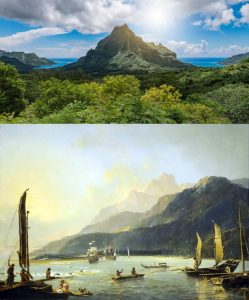 Depending on seasonal trade winds and dominant Pacific ocean currents any competent Master would navigate a route which might be expected to pass by and perhaps call into New Zealand, other smaller southern Pacific islands, or even Tahiti which is close to the Tropic of Capricorn. The upper image at left here is taken from the inland aspect of the backdrop mountain facing Cook’s Bay, Moorea Island, Tahiti, the lower one from a painting by Hodge showing Captain Cook’s ships Resolution and Adventure in Matavai Bay, Tahiti main island, 1776, each illustrative of the steepness and ruggedness typical of each of the of the Tahiti coastal island terrains – and all closely reminiscent of the Skelton painting’s backdrop mountains. They are equally typical of many of the Pacific islands, reflecting their volcanic origins. Had Skelton in its 1823/24 voyage visited Tahiti it is most likely it would have been at Matavai Bay. (Public Domain images)
Depending on seasonal trade winds and dominant Pacific ocean currents any competent Master would navigate a route which might be expected to pass by and perhaps call into New Zealand, other smaller southern Pacific islands, or even Tahiti which is close to the Tropic of Capricorn. The upper image at left here is taken from the inland aspect of the backdrop mountain facing Cook’s Bay, Moorea Island, Tahiti, the lower one from a painting by Hodge showing Captain Cook’s ships Resolution and Adventure in Matavai Bay, Tahiti main island, 1776, each illustrative of the steepness and ruggedness typical of each of the of the Tahiti coastal island terrains – and all closely reminiscent of the Skelton painting’s backdrop mountains. They are equally typical of many of the Pacific islands, reflecting their volcanic origins. Had Skelton in its 1823/24 voyage visited Tahiti it is most likely it would have been at Matavai Bay. (Public Domain images)
Further, the native craft seen in the Skelton painting, considered by Professor Boomert not to be of Caribbean indigenese style, appear to bear a strong resemblance to Polynesian style canoe craft – images of NZ Maori warrior craft show similar lines with high prows. See also this Getty Image via the link – in this the natives are wearing headpieces and loin covers with very strong resemblance to those in the painting image. Tahitian Image of HMS Dolphin, Captain Samuel Wallis, 1767
Recent (2023) advice from anthropologist Professor Patrick Kirch of the University of Hawaii – Professor Kirch is a recognised authority on Polynesian cultures and histories – he decisively rules out Tahiti and the Pacific Polynesian islands generally as a location – He states “I can tell you that the image is NOT of Tahiti, or for that matter anywhere in Polynesia. Houses and canoe styles are all wrong. Based on the lanteen sails of the canoes, possibly somewhere in island Southeast Asia? Indonesia?”
It must be said however that the referenced Tahitian image of Captain Wallis’ ship under attack does seem to contradict this, the garb and canoe styles looking remarkably like those in our alleged Skelton painting.
It is interesting that both Professors Boomert and Kirch suggested a Southeast Asian location as being more likely. We have no evidence of Skelton having sailed in Southeast Asian waters but we have no details from its other voyages into Australia waters as to routes and other ports of call other than its return to England via the Pacific Ocean and Cape Horn following its presence in Australia in the 1820s.
******************************************************************************
A new discovery potentially of significance (which this researcher/writer had previously overlooked) was that one of the passengers sometime on board was a Charles Fraser, Colonial Botanist. Fraser (sometimes referred to as Frazer, and described in official papers as a plant collector and illustrator) engaged as botanist variously in VDL, NZ , NSW mainland, and WA during which time he identified and recorded many hundreds of plant species – recording these involved sketching/painting images of them and lodging them with an official Government repository.
Thus, as was the case with nearly all field botanists in that pre-photography era, Fraser was an accomplished artist of native flora which would presumably equip him with quite adequate skills to create a painted image of the Skelton quality.
This raises the question – has what has been recorded (see above) as the likely artist of the Skelton painting as G Fraser been incorrectly read as a G instead of a C – this does seem quite a coincidence indeed.
A Charles Fraser – George Bowes Fraser relationship ? – Whilst GBF is the right age to be a son of CF, it cannot be, but an alternative explanation could be that Charles Fraser (Botanist, b.Scotland 1788, d.Sydney 1831) is related in a more distant way to George Bowes Fraser (Accountant, b.1809, d.1881). Their mutual connections with Skelton the ship and Skelton the painting can suggest the possibility of some kind of personal relationship. The record cited above indicates Charles at death left no relatives in Australia, so unmarried or no Issue – a search of NSW BDM records confirms he died in Sydney in 1831, was interred at St. John’s, Parramatta, but no marriage or children relationships could be identified. A Scottish record of his death indicates he had at least one brother, John.
A search of Victorian BDM records shows GBF to have been born at Inverness, Scotland, 1809 and records his father also as George Bowes Fraser (mother unnamed) – however a check of Scottish BDM records states his father to be William Fraser and his mother Sarah nee McDonald, and that he was christened October 13, 1807 – one might expect the Scottish records to be the more valid. Fraser emigrated to VDL in 1833, remained there for 6 years then married and moved to Geelong, Victoria in 1839. He and his spouse did not have children – so no issue to whom the Skelton painting might be willed.
A pre VDL CF/GBF relationship back in Scotland remains an open question – a search of Scottish records may shed light!
A Reasonable Conclusion ? – In all of the preceeding evidences are numerous circumstantial items in our search for the answer to our primary question – ‘The Barque Skelton – is this our Ship ?’. No evidence circumstantial or otherwise has been discovered which presents a contrary position, ie, that the painting is of another ship or location.
Taken together, but particularly with the Roadknight passenger family’s recorded statement that the painting was of the Skelton, the discovery of a possible Charles/George Fraser connection, and the handwritten note on the painting’s rear stating it to be a Teneriffe location which was a regular resupply port of call for most British and western European shipping enroute to the ports of southern Africa, Brazil (Rio), the East Indies and Australia. As were many Caribbean ports, but as we have seen contradicted by the opinion of our cited experts.
It is the opinion of the writer that artist G B Fraser, painted the image after settling and residing in Hobart and simply ‘artistically created’ fore and backdrop scenarios based on his having seen various of the locations in his travels – Teneriffe, or Trinidad or Tahitian mountainous island backdrops – likewise his recollection of the natives, their garb and canoes which notwithstanding Professor Kirch’s contrary comments, do bear a very strong resemblance to the original Tahitian depiction from Captain Wallis’ 1767 visit there. Is this not a reasonable conclusion, albeit subject to any new evidence emerging.
Notes – 1) During research and writing of this article contact and information exchanges were made with descendants of the Roadknight, Headlam, and McDonald families who were fellow voyagers of the Wilsons on Skelton
2) Mr Brown has more recently moved to live in London, where he advises the Skelton painting adorns his living room wall – might we say our ship has at last returned to a home port!)
- Captain James Dixon
- Skelton-Castle Residence
- Map-Antigua-Caribbean

